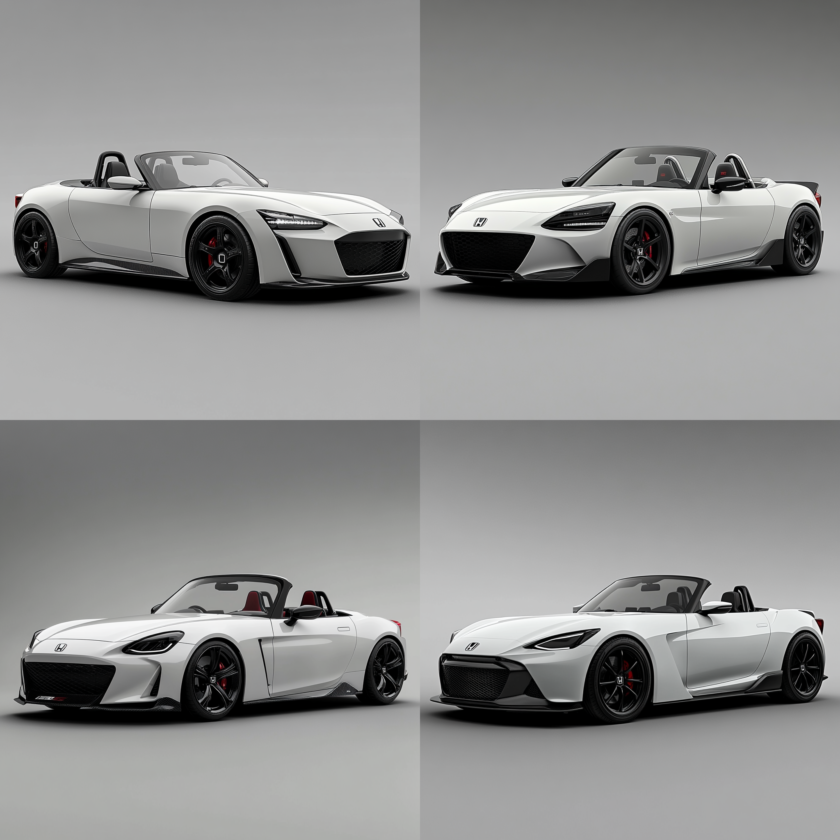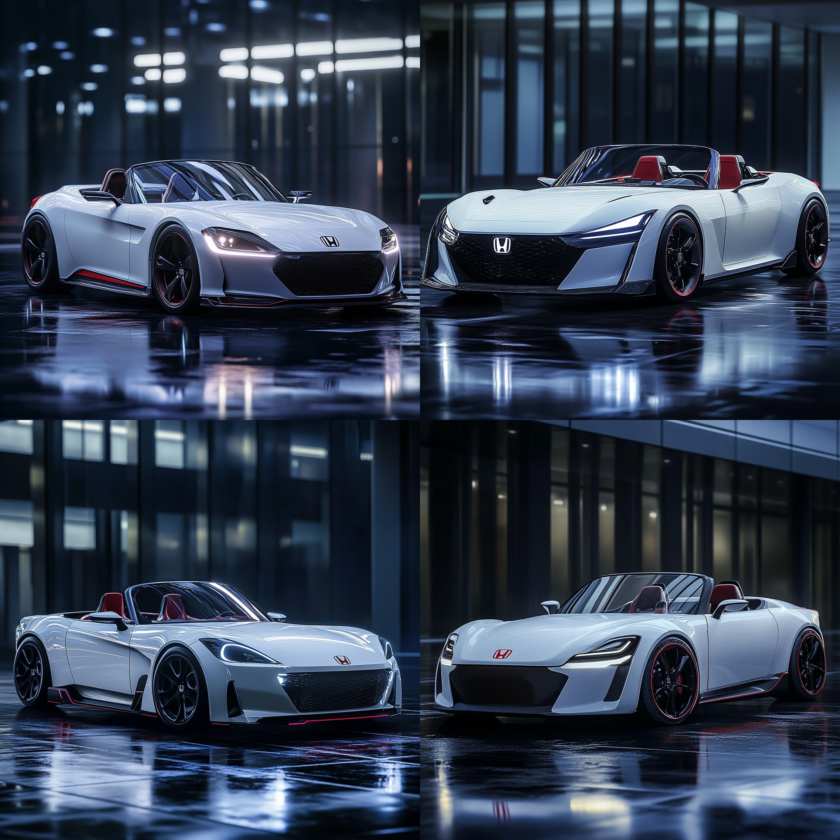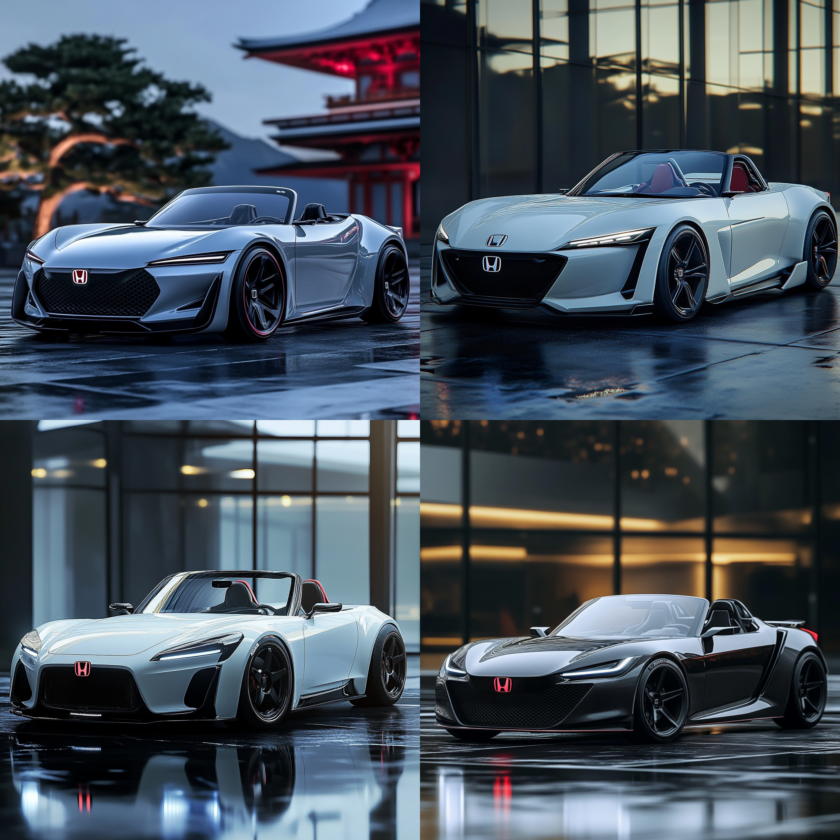
Honda S2000 was created as a true gift for the company’s 50th anniversary in 1999. Its concept was to revive the spirit of the classic S-series roadsters (S500, S600, S800) from the 1960s, but with a modern interpretation. The car was designed to embody Honda’s engineering excellence and demonstrate its leadership in developing high-tech sports cars.
The Concept and Idea
The main idea behind the S2000 was to create a lightweight, agile, and powerful sports car tailored for true driving enthusiasts. The engineers focused on delivering pure driving pleasure by combining:
Perfect balance.
Advanced technologies characteristic of Honda.
A sporty yet approachable design that would appeal to both young drivers and seasoned enthusiasts.
The Development Team
Engineer: Shigeru Uehara, who had previously worked on the legendary Honda NSX. Uehara aimed to create a car that matched the NSX in driving quality but was more accessible. He infused the project with the philosophy of “man and machine as one.”
Designer: Daisuke Sawai. His mission was to craft a car with the classic proportions of a roadster: a long hood, low stance, and compact body. The design harmonized elegance with sportiness.
The Spirit of Innovation
The Honda S2000 became the embodiment of how the company envisioned the future of sports cars: pure driving dynamics, everyday usability, and minimalist design. It immediately captured the attention of automotive enthusiasts, blending tradition and innovation to become a modern classic.

Specifications of Honda S2000 1. Power: 240 hp (179 kW) at 8,300 rpm 2. Acceleration: 0-60 mph (0-100 km/h) in approximately 5.4 seconds 3. Top Speed: Around 150 mph (241 km/h) 4. Engine: Engine type: 2.0L I4 (F20C) for the original AP1 model (1999-2003) 2.2L I4 (F22C1) for the later AP2 model (2004-2009) 5. Range: Approximate fuel range: 300 miles (480 km) with a full tank (depending on driving style) 6. Dimensions: Length: 4,110 mm (161.8 in) Width: 1,745 mm (68.7 in) Height: 1,280 mm (50.4 in) Wheelbase: 2,380 mm (93.7 in) Curb weight: 1,280 kg (2,822 lbs) 7. Technology: Variable Valve Timing and Lift Electronic Control (VTEC) Independent double-wishbone suspension for both front and rear Electronic Limited Slip Differential (LSD) Advanced traction control system Aluminum hood, doors, and trunk lid for weight reduction 8. Additional Features: Manual soft top convertible Lightweight and driver-focused interior Tachometer with redline at 9,000 rpm, placed centrally on the dashboard Air conditioning and premium sound system available in certain trims
Read too: New Citroën SM 2025: The legendary grand tourer reimagined for a new era

Interesting facts about Honda S2000:
1. Highest RPM for a Production Engine:
Honda S2000 has one of the highest RPMs for a production naturally aspirated engine. Its 2.0-liter F20C engine reached 8,300 RPM, with the redline set at an impressive 9,000 RPM. This allowed the car to generate incredible power and offer excellent handling.
2. Mathematical Weight Distribution Precision:
Honda S2000 was designed with perfect 50:50 weight distribution between the front and rear axles. This means the car has exceptional handling, providing the driver with control and stability during high-speed maneuvers.
3. Innovations in Suspension:
A distinctive feature of the S2000 is its suspension. It uses an independent double-wishbone suspension system both front and rear, ensuring outstanding stability and precision on the road.
4. Mechanical Philosophy and Control:
S2000 is known for its “mechanical” philosophy, where every element of the car feels like it’s built specifically for the driver. For example, even the soft top feels like an integral part of the sports car, and the driver can manually close it without any electronic systems.
5. Popularity in Video Games and Movies:
S2000 gained massive popularity due to its appearances in movies like The Fast and the Furious. It became a fan favorite in video games, particularly in the Gran Turismo series, where it was one of the best sports cars.
6. Commitment to the “Pure Driving” Concept:
Honda S2000 was designed as a sports car that delivers the utmost driving pleasure. It didn’t feature luxury or assistive technologies, such as automatic transmission. It was a “pure” sports car for drivers who appreciate manual control and driving excitement.
7. Long Production Cycle:
The production of the S2000 lasted from 1999 to 2009, which is rare for sports cars. This was made possible by its remarkable reliability and popularity among enthusiasts. Over these years, the model underwent only minor updates.
Read too: Oldsmobile Aerotech: The concept that redefined automotive innovation

Honda S2000 was not just a car for daily commutes and weekend getaways – it also proved itself incredibly successful on racetracks, earning popularity among car enthusiasts and motorsport competitors. Its sporting potential and outstanding handling made the S2000 the perfect choice for those looking for a track-ready car.
1. Track-Ready Preparation
Honda S2000 was designed to maximize its power and efficiency on the track. Its lightweight construction, precise handling, and stability at high speeds made it one of the best cars in its class for track racing. With an excellent power-to-weight ratio, it was capable of reaching impressive speeds without sacrificing handling.
Honda engineers created a car that would cater to drivers looking for aggressive track driving, while still maintaining comfort for everyday use.
2. The F20C Engine on Track
One of the key factors that made the S2000 ideal for the track was its F20C engine. With a 2.0-liter displacement and impressive power output of 240 hp at 8,300 rpm (and a redline of 9,000 rpm), this engine was a true star on the racetrack. The high-revving nature allowed the S2000 to accelerate quickly and maintain high speeds without losing power.
All these characteristics allowed the car to perform excellently on straightaways and navigate corners with great stability and control.
3. Suspension and Handling
The double wishbone suspension at both the front and rear axles provided exceptional stability through corners and reduced body roll, which is critical at high speeds and during sharp maneuvers. The double wishbone setup kept the wheels in constant contact with the road, giving drivers greater confidence when navigating curves.
This suspension, combined with the rear-wheel-drive layout and perfect balance, made the car extremely responsive and nimble on track. All of these factors allowed the S2000 to compete on equal footing with some more expensive sports cars.
4. Track Modifications
While the standard version of the S2000 was already a fantastic track car, many owners opted to make modifications to enhance its capabilities even further. Upgrades like sports shocks, better engine cooling, lightweight forged wheels, and track-focused tires significantly boosted the car’s track performance.
Honda even created a special track-oriented version, the S2000 CR (Club Racer), released in 2008, specifically designed for racing. It featured an improved suspension, enhanced aerodynamics, and reinforced structural elements to ensure maximum stability and efficiency on the track.
5. Competition on the Track
On the track, the Honda S2000 gained popularity not only because of its capabilities but also due to its participation in various racing events. It competed in the “SCCA National Auto Cross” series, where it went head-to-head with other sports cars. It was frequently compared with more expensive competitors like the Nissan 350Z, Mazda RX-8, and BMW Z4, and it often showed exceptional results.
Thanks to its characteristics and ability to compete with more expensive rivals, the S2000 gained a lot of fans on the track and became popular worldwide.
6. Motorsport Participation
Honda S2000 was not only popular among private racers but also actively used in professional competitions, such as Time Attack and Drift Racing. In these disciplines, the car proved itself to be extremely capable under high stress and aggressive driving.
All these aspects make Honda S2000 not just a car for the track, but a symbol of sporting spirit, precision, and engineering excellence, marking an important chapter in motorsport history.
Read too: New Porsche 914 2025: A modern take on a 70s icon

Conclusion
Honda S2000 remains an icon of engineering brilliance and racing spirit. Its combination of lightweight construction, high-revving engine, and exceptional handling made it not only a favorite for enthusiasts but also a serious contender on the track. From its origins as a celebration of Honda’s 50th anniversary to its lasting legacy in motorsport and car culture, the S2000 proved that a well-balanced, driver-focused car can stand the test of time.
Whether competing against rivals on the track or delivering the thrill of driving on winding roads, the S2000 showcased Honda’s dedication to performance and innovation. To this day, it continues to inspire drivers and racers alike, proving that it was not just a car of its time but a true masterpiece in automotive history.
Raed too: Mazda R360 2025: The return of a Japanese icon
New Honda S2000:
Future Classics: 8/10
Brand Recognition: 9/10
Design Modernity: 9/10
CarsCorn Score: 8.7/10










